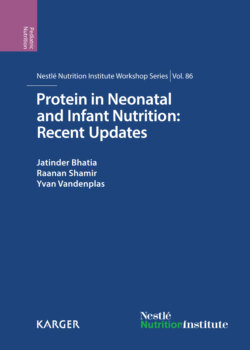Читать книгу Protein in Neonatal and Infant Nutrition: Recent Updates - Группа авторов - Страница 13
На сайте Литреса книга снята с продажи.
Proteins, Peptides and Amino Acids: Definitions
ОглавлениеProteins, from the Greek proetios (meaning ‘first’), are a fundamental component for life. They are the second most abundant chemical compound in the body after water. Following digestion, dietary proteins are absorbed as amino acids, which then contribute to the total amino acid pool, from which the body’s proteins are synthetized. Proteins are the main building blocks of the body and are involved in maintaining numerous body functions, in repairing or replacing cells or tissues, and in growth.
Table 1. Essential and nonessential amino acids
| Nonessential amino acids (can be synthetized by the human body) | Conditionally essential amino acids (can be synthetized by the human body except in certain conditions) | Essential amino acids (cannot be synthetized by the human body; must be supplied through nutrition) |
| Alanine | Arginine | Histidine |
| Aspartate | Asparagine | Isoleucine |
| Glutamate | Cysteine1 | Leucine |
| Glutamine | Lysine | |
| Glycine | Methionine | |
| Proline | Phenylalanine | |
| Serine | Threonine | |
| Tyrosine1 | Tryptophan | |
| Valine | ||
| 1 Requires essential amino acid precursors (methionine and phenylalanine). |
They are polymers, built from 20 different amino acids. The distinction between proteins and peptides is their size. Peptides are chains of 2-30 amino acids and proteins are peptides that consist of more than 30 amino acids. The various properties of peptides and proteins depend not only on their component amino acids and their sequence in peptide chains, but also on the way the peptide chains are stretched, coiled or folded in space in secondary structures. Proteins and large peptides adopt a geometric shape, which is referred to as tertiary structure, and finally many proteins are actually assemblies of several polypeptides, which are known as protein subunits.
Unlike other macronutrients such as fat or carbohydrates, the body does not have major protein stores. Therefore, proteins must be supplied from dietary sources. Some amino acids are essential dietary components, since they are not synthetized by human metabolic processes. All 20 amino acids are important for protein synthesis, but some can be synthetized from other metabolic precursors: they are called the nonessential amino acids. Others cannot be synthetized by the human body and then have to be supplied through nutrition: they are the essential amino acids. A third category consists of the conditionally essential amino acids; they can be synthetized by the human body except in certain conditions (e.g. trauma, stress, sepsis or surgery) when the physiological demands may result in the need for these nonessential amino acids to be greater than the body’s ability to produce them (table 1).
Fig. 1. Proteins influence all aspects of growth and development.
Proteins are nutrients essential to life. They are present in and vital to every living cell. They are essential for healthy growth and development, and also influence major functions of the body (fig. 1). In the form of skin, hair, callus, cartilage, muscles, tendons and ligaments, proteins hold together, protect and provide structure to the body. In the form of enzymes, hormones, antibodies and globulins, they catalyze, regulate and ensure proper functioning of the body. In the form of hemoglobin, myoglobin and various lipoproteins, they transport oxygen and other substances in the organism.
